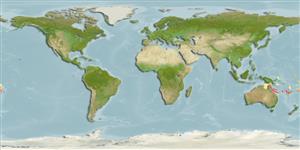Classification / Names
Common names | Synonyms | Catalog of Fishes(genus, species) | ITIS | CoL | WoRMS | Cloffa
Teleostei (teleosts) >
Perciformes/Serranoidei (Groupers) >
Anthiadidae (Fairy basslets or Streamer basses)
Etymology: Rabaulichthys: Perhaps from Rabaul, the capital of Papua New Guinea + Greek, ichthys = fish.
Eponymy: Cadel Squire collected most of the type series. With his brother Lyle (below), he runs ‘Cairns Marine’, an Australian company exporting marine fauna. (Ref. 128868), visit book page.
More on authors: Randall & Walsh.
Environment: milieu / climate zone / depth range / distribution range
Ecology
Marine; reef-associated; depth range 6 - 54 m (Ref. 90856). Tropical
Western Pacific: Australia,
Size / Weight / Age
Maturity: Lm ? range ? - ? cm
Max length : 6.2 cm SL male/unsexed; (Ref. 90856)
Short description
Identification keys | Morphology | Morphometrics
Dorsal spines (total): 10; Dorsal soft rays (total): 16; Anal spines: 3; Anal soft rays: 7; Vertebrae: 26. This species is distinguished by the following characters: D X,16; A III,7; pectoral rays 19--21 (rarely 21); lateral-line scales 51-59; gill rakers 9 + 23-24; body depth 23.8-25.3% SL; head length 28.5-30.6% HL; snout length 6.8-7.4% SL; longest dorsal spine of mature males 28.7-31.3% SL; caudal fin of mature males 31.8-35.8% SL; absence of black band in soft portion of dorsal fin; a series of indistinct dark bars of unequal width in middle third of standard length, none with pale margins; in life, colour light red with scale centres pale, dark bars reddish brown; an oblique, pale-edged, brownish orange band from snout through eye and across cheek; pelvic fins black with red rays; colour of remaining fins pink to yellowish (Ref. 90856).
The species is usually found over open stretches of coral rubble, and therefore avoid the many predators of coral reefs; form small aggregations that feed on zooplankton above the substratum (Ref. 90856).
Life cycle and mating behavior
Maturity | Reproduction | Spawning | Eggs | Fecundity | Larvae
Randall, J.E. and F, Walsh, 2010. Rabaulichthys squirei, a new species of Sailfin Anthias (Serranidae: Anthiinae) from the Coral Sea. Memoirs of the Queensland Museum - Nature 55(1):205-211. (Ref. 90856)
IUCN Red List Status (Ref. 130435: Version 2024-1)
Threat to humans
Harmless
Human uses
Tools
Special reports
Download XML
Internet sources
Estimates based on models
Preferred temperature (Ref.
123201): 25.9 - 27, mean 26.3 °C (based on 20 cells).
Phylogenetic diversity index (Ref.
82804): PD
50 = 0.5625 [Uniqueness, from 0.5 = low to 2.0 = high].
Bayesian length-weight: a=0.00389 (0.00180 - 0.00842), b=3.12 (2.94 - 3.30), in cm total length, based on all LWR estimates for this body shape (Ref.
93245).
Trophic level (Ref.
69278): 3.3 ±0.4 se; based on size and trophs of closest relatives
Fishing Vulnerability (Ref.
59153): Low vulnerability (10 of 100).
